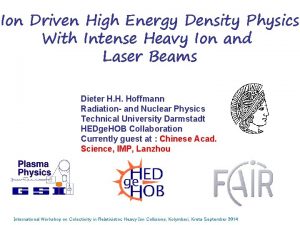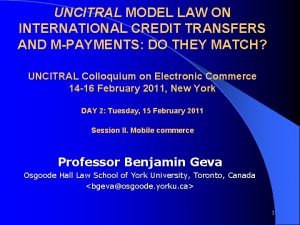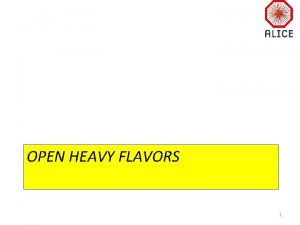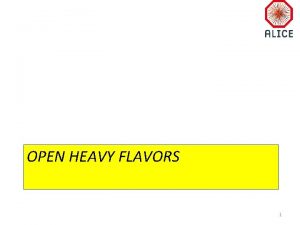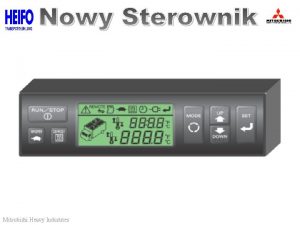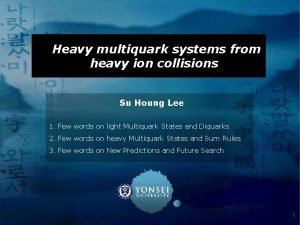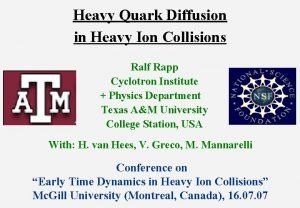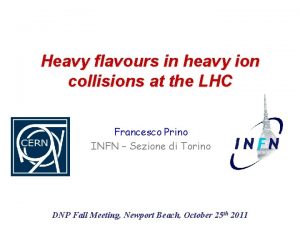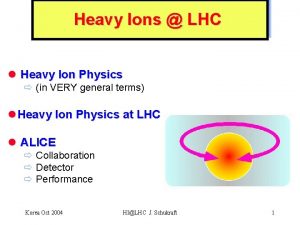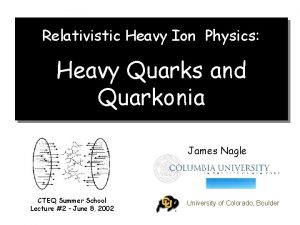Particle transfers in heavy ion reactions Particle transfers











- Slides: 11

Particle transfers in heavy ion reactions

Particle transfers in Heavy ion reactions: • • Deuteron stripping is a process of direct reaction in which proton or neutron in the incident deuteron is captured without the formation of Compound Nucleus. Such reactions are noticed in heavy ion interactions also. Hence in addition to single particle transfer, clusters of particles are also transferred.

• • Transfer of particles takes place at grazing incidence. When the incident energies are significantly less compare to coulomb barriers and coulomb phenomena are dominant we see these interactions also.

• • 197 Au(14 N, 13 N)198 Au is a neutron transfer reaction. When for such reaction is plotted as a function of θcm for various projectile energies we get angular distribution as shown in the figure 1.


The scattering will be forward peaked as the energy increases. (dσ/dΩ )=0 for angles θ≤ 20 o and (dσ/dΩ)≈0 for angles θ≥ 130 o. ie. There is no transfer for large impact parameter and very little transfer for small impact parameters. For small impact parameters Compound nucleus reactions predominates. Maximum likelihood of transfer corresponds to grazing impact parameters ie. for a definite angle in central of mass system frame.

• If dσ/d. Rmin is plotted as a function of Rmin all points fall on a smooth curve with a maximum at a value of Rmin equal to nuclear interaction radius (figure 2). • This indicates that this transfer process is a surface phenomena.

Figure 2

This process is explained on classical and semi classical and quantum mechanical pictures. Early semi classical theory was given by Breit. According to this approach the particles have coulomb orbits and there is a small chance of overlap of the nuclear wave function.

According to semi classical theory of Breit the nucleons tunnels through the inter nuclear barrier at the distance of closest approach. • Transfer is a tunnel process. • A particle which was bound in a nucleus tunnels through and goes into a bound state in another nucleus.

Probability of transfer=probability of capturing of nuclear wave function. Probability of transfer = The simple theory predicts that For situation where there is not absorption of particles.
 Ratey rational functions
Ratey rational functions Heavy ion
Heavy ion Section 2 classifying chemical reactions worksheet answers
Section 2 classifying chemical reactions worksheet answers Chemistry unit 5 reactions balancing reactions worksheet
Chemistry unit 5 reactions balancing reactions worksheet Redox reaction
Redox reaction Section 2 reinforcement classifying chemical reactions
Section 2 reinforcement classifying chemical reactions Types of reactions
Types of reactions Fuerzas de london
Fuerzas de london What is london forces
What is london forces Ejemplo de fuerza ion ion
Ejemplo de fuerza ion ion Ejemplo de fuerza ion ion
Ejemplo de fuerza ion ion Uncitral model law on international credit transfers
Uncitral model law on international credit transfers

